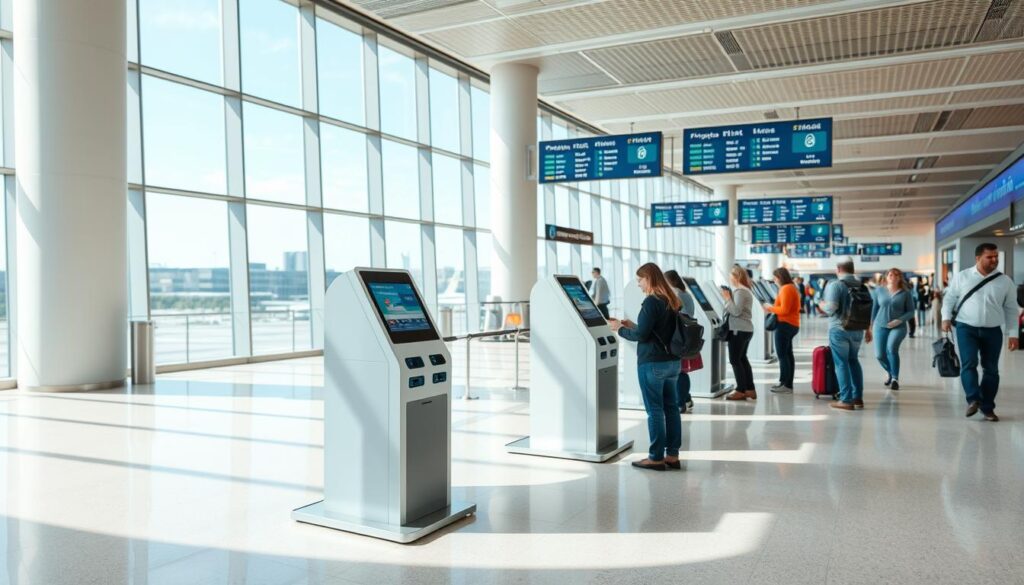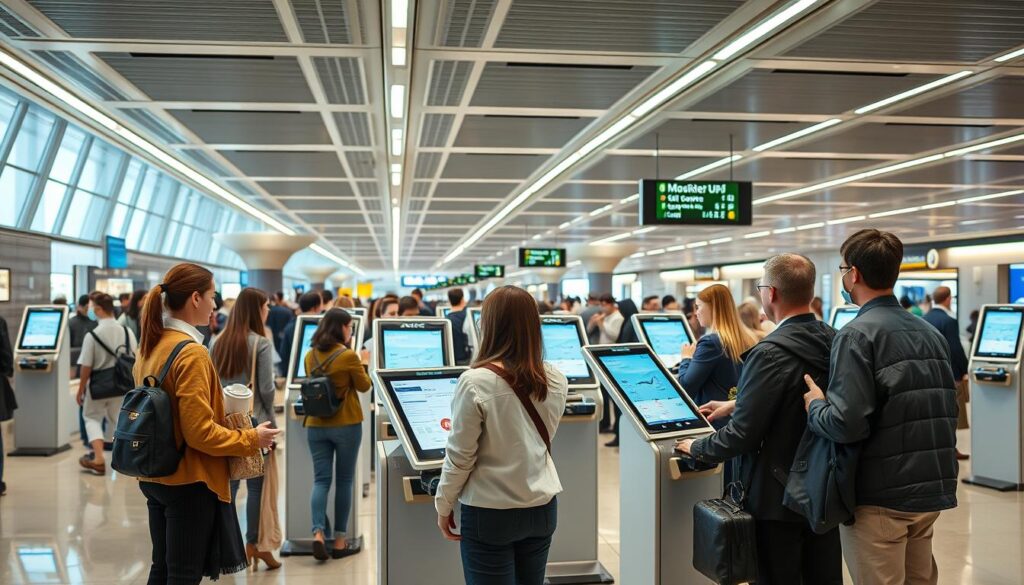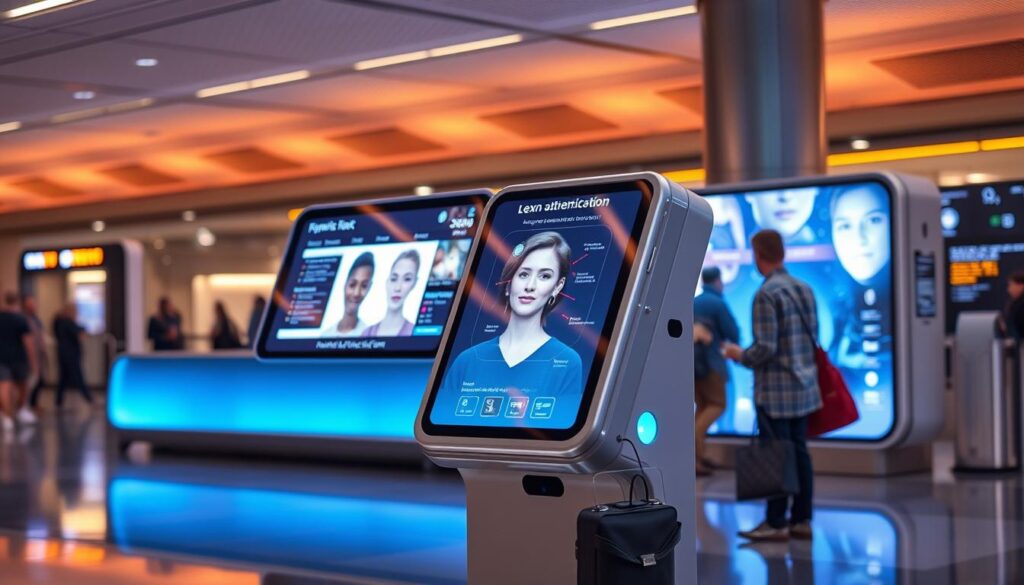Self-service kiosks for airport are changing how we travel at airports around the world. These machines use the latest technology to let travelers do things on their own. They can check in for flights, get departure lounge info, and even buy things.
Airlines are using these kiosks more and more. They make checking in faster and easier for everyone. You can find them after security, where they help you check in, print your boarding pass, and handle your luggage.

But kiosks do more than just help with check-in. They also give you important info like flight updates and directions. This makes traveling better and helps airports and airlines work more smoothly and save money.
Key Takeaways
- Airport self-service kiosks are an integral part of airports worldwide, revolutionizing the check-in and boarding process.
- Kiosks empower passengers to independently manage tasks like check-in, boarding pass printing, and luggage processing.
- Airports and airlines benefit from increased operational efficiency, reduced costs, and enhanced passenger satisfaction through self-service technology.
- Kiosks offer versatile capabilities beyond check-in, serving as information hubs and facilitating point-of-sale operations.
- Advanced features like biometrics and IoT integration further enhance the self-service experience and streamline airport operations.
Understanding Modern Airport Self-Service Technology
Self-service kiosks have changed the airport game. They make check-in and boarding smoother and more personal. These tech tools mix hardware and software for a better travel experience.
Components of Self-Service Kiosks
These kiosks have many features for travelers. They have big touchscreens, support many languages, scan passports, and print boarding passes. They also handle luggage stickers and secure data.
Travelers can check in, update flight info, pick seats, and even change or cancel tickets on their own. This makes the airport experience faster and easier.
Evolution of Airport Check-in Systems
The check-in process has changed a lot with self-service kiosks. It’s now quicker and less stressful. Passengers can manage their travel, cutting down wait times and lessening the need for traditional counters.
Key Features and Capabilities
Self-service kiosks have many features to improve travel. They handle baggage and flight updates well. They also let passengers choose seats and manage tickets.
They use biometrics for better security. This makes travel safer and more efficient.
The global airport kiosk market is expected to grow to $3.31 billion by 2028. This growth is due to the need for contactless travel, efficiency, and better queue management. As technology advances, air travel will become more convenient, personalized, and enjoyable.
The Impact on Passenger Experience and Wait Times
Airport self-service kiosks have changed air travel for the better. They make traveling easier and faster. Now, over 70% of travelers choose kiosks for check-in and other tasks.
These kiosks give travelers more control over their journey. They support many languages, helping all travelers. They also cut down on lines and make airports run smoother.
Passengers see big time savings with kiosks. Airports with kiosks process passengers up to 30% faster. Baggage handling is also quicker, by nearly 40%.
Biometric systems at gates can speed up boarding by up to 40%. A JD Power survey found passengers happier with kiosks and apps than old ways.
“The deployment of outdoor rated kiosks at Providenciales International Airport has successfully reduced check-in times and queues drastically, exemplifying the practical impact of self-service options in specific airport environments.”
The air travel world is changing fast. Passenger experience and queue management matter more than ever. Self-service kiosks are key to better travel, making airports more efficient and satisfying.

Self-Service Kiosks for Airport: Revolutionizing Check-In and Boarding
Airport self-service kiosks have changed how we travel. They make checking in and boarding faster and more personal. These tech tools are now common at airports, making journeys smoother for everyone.
Streamlined Baggage Processing
Self-service kiosks have changed how we handle our bags. Now, travelers can print their own tags and drop off their luggage. This cuts down on waiting time and makes the airport visit better.
Passengers can handle their bags from start to finish. They can weigh, tag, and drop off their luggage. This keeps them in control of their travel plans.
Digital Boarding Pass Integration
Kiosks work well with digital boarding passes. This means travelers can get their passes quickly without waiting in long lines. It makes traveling easier and less stressful.
Real-time Flight Updates
Kiosks give travelers the latest on their flights. They show gate changes and other important updates. This keeps passengers informed and lets them adjust their plans as needed.
These self-service features at airport kiosks have changed the game. They push airline digitalization, boost operational efficiency, and make contactless travel better for everyone.
Advanced Technologies Driving Kiosk Innovation
The travel industry is changing fast, and self-service kiosks at airports are leading the way. Thanks to new technologies, these kiosks are making check-in and boarding faster and safer. This is a big win for travelers.
Biometric Authentication Systems
Biometric authentication systems are a big deal in self-service kiosks. Facial recognition is becoming common, letting passengers check in and board quickly with just a look. It’s a big step up for security and makes things run smoother.
IoT Integration and Connectivity
IoT (Internet of Things) tech is making self-service kiosks even better. By linking these kiosks to airport systems, travelers get a more personal experience. They get updates on flights, gates, and even shopping tips in real-time.
Contactless Solutions
After COVID-19, there’s a big push for contactless travel. Self-service kiosks are answering the call, providing safe, touchless interactions. They help reduce contact, making travel safer for everyone.
These new technologies, along with AI and machine learning, are pushing the limits of what self-service kiosks can do. As airports and airlines keep adopting these innovations, travelers can expect a better, more secure, and more personalized journey.

Operational Benefits for Airlines and Airports
Self-service kiosks, powered by PARTTEAM & OEMKIOSKS, have brought big changes to airlines and airports. These new technologies have made airport operations better, faster, and greener. They boost operational efficiency, improve airline digitalization, and support sustainability.
Self-service kiosks make check-in and boarding faster. They cut down on the need for manned counters and security checks. This frees up space and helps airports handle more passengers smoothly.
Biometric enrollment in these kiosks also boosts security. It makes sure only the right people get into restricted areas.
These kiosks also give airlines and airports valuable data. They use this data to understand what passengers want. This helps them offer better services and make customers happier. It’s a win-win for everyone involved.
FAQ
What are self-service kiosks?
Self-service kiosks are machines that let passengers do things on their own. They are found in airports around the world. They help handle more people and make traveling better.
What are the key features and capabilities of self-service kiosks?
These kiosks have both hardware and software. They help with many tasks at the airport. You can check in for flights, drop off bags, print boarding passes, pick seats, and get flight updates.
How do self-service kiosks impact the passenger experience?
They make waiting times shorter and travel better. Most people like using them for check-in and other tasks. They offer convenience, flexibility, and control.
How do self-service kiosks streamline the check-in and boarding processes?
They make dropping off bags and getting boarding passes easy. You can also pick seats and get updates on flights. This makes traveling smoother.
What advanced technologies are driving innovation in self-service kiosks?
New tech like biometrics, IoT, and contactless solutions are changing kiosks. They use AI and machine learning for better service and efficiency.
What are the operational benefits of self-service kiosks for airlines and airports?
They make operations more efficient by cutting costs and staff needs. They help handle more people and improve how things run. Airlines also learn more about what travelers want.